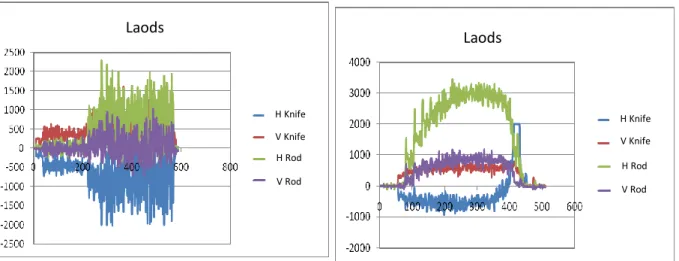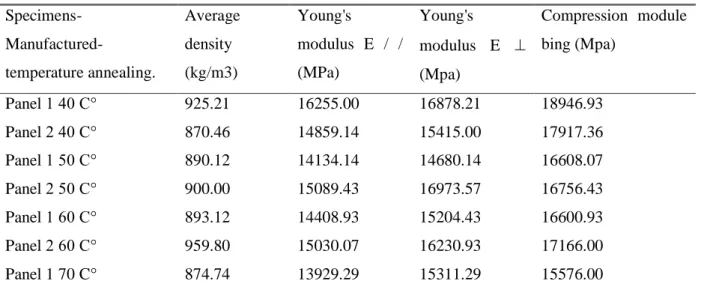104
INFLUENCE OF BOILING TEMPERATURE ON THE
PANELS LVL (LAMINATED VENEER LUMBER) QUALITY
MADE WITH OAK (CANARIENSIS) ALGERIA WOOD
Salim Kennouche
Abdelatif Zerizer
Abdelhamid Aknouche
Département Génie Des Matériaux, FSI, cite Frantz Fanon,Boumerdes, Algérie
Marchal Remy
ENSAM, LABOMAP, Ecole d’Art & Metier de Cluny, Rue Porte de Paris,Cluny, France.
Abstract
The panels LVL (Laminated Veneer Lumber) are less used in construction, which are
produced by peeling trunk of trees, undergone baking operation which one determined the
quality of plating and LVL panels made by gluing. Our study here consist to vary the boiling
temperatures ranging from 40C°, 50 C°, 60 C°, to 70 C° (two panels are drawn for each
temperature, and 14 specimens (20 * 20 * 336mm) for each panels) that was secure settings
peeling, speed of rotation of the lathe, pressure bar, clearance angle of the knife and the
thickness of the veneer, as we fix the amount of glue 400g / cm
2, the pressure pressing the
panels in order to clearly identify the influence of baking temperature logs of Algerian oak
wood quality. Our controls are carried out by non-destructive testing after that the specimens
are tested with destructive method under four point bending, according to the perpendicular
direction and parallel plating, and we took into consideration the calculation of Young's
modulus and stress at break for each series of panels.
Keywords: Panels, gluing, rotary, mechanical characterization, Young's modulus
1. Introduction
Algerian Oak wood is a little gasoline used by the timber industry except for heat. This project has the goal of making a second test of these oaks in seeking the way to value them in the
105
industry of wood [1]. We will consider these oaks have good mechanical properties (hardness, density ...).
These images have visions under the electron microscope (SEM) samples of oak Corsica.
Fig. 1. SEM image of Algerian oak wood.
We developed LVL 8 panels (500 * 500 * 20) mm, with the parameters of unwinding after a thickness of 3.2 mm, a compression ratio of 10 %, the rake angle is 0° and temperatures annealing range from 40C ° to 70C ° with a cutting speed of 1m/s [2].
2. Preparation of panels
The logs of Algerian oak wood are steamed in an oven lab, including a rotating menu
of a water thermostat temperature controller that maintains the selected temperature, in our
case is steaming at temperatures
40C °, 50 C ° 60 C ° 70 C ° for
24
hours,
every
24
hours
removing a log and it makes the
peeling process with a thickness
of 3.2 mm.
The sheets obtained by peeling the logs of oak horns at different annealing temperature: 40C
° 50C ° 60C ° 70C ° are cut Fig. 2. Semi-industrial lathe.
using the cutter, in sheets of 50 cm, and dry with a fan, to a moisture content ranging from 7 to 10%.
(1) Two pairs of pins for driving the ridges of the telescopic type with a diameter of respectively 110 and 70 mm.
(2) A slide knife 225 mm maximum stroke.
(3) A knife 950 mm long, held together by screws manual. The nozzle angle is 20 °.
(4) A bar of pressure angle, manually adjustable, its support is linked to the knife carriage. (5) A roll anti-buckling, always willing to 36 ° from the vertical axis of the pins.
(6) An automatic retractable and removable veneer.
X 100/ 200µm X 170/ 200µm
We therefore explored in this study a recovery by peeling which allows better material yield. We held to account in the baking
temperature varied from 40 C°,
50 C°, 60 C° and 70 C°, and set the thickness of the veneer to 3.2 mm.
106
(7) 4 piezoelectric quartz sensors to capture efforts.
Cutting force: The cutting forces exerted on the knife and pressure bar in the horizontal and vertical direction as a function of annealing temperature are summarized in the following table:
TABLE I. Cutting Forces During Peeling
Cutting force on the knife (Dan) Cutting force on the bar (Dan) Temperature (C°) Fine mesh Middle mesh Coarse Mesh Reference
40C° -877.58 586.79 818.56 94.51
50C° -464.20 597.38 552.92 584.60
60C° 818.56 2798.53 1830.16 1749.54
70C° 94.51 825.39 534.85 407.31
Several authors have mentioned that the cutting forces are very weak (Marchal et al. 2009). To play on the cutting forces exerted on the knife, we can say that for logs steaming at temperatures of 40C ° to 50C ° there a dive knife on the subject, this is explained by the negative direction the value of the cutting force exerted on the knife, and was a civil refusal to cut logs for steaming at temperatures 60C ° to 70C °. Stable control is one that allows for a very low dipping tool, a value of Y close to zero but slightly negative [3].
The following curves refer to the efforts of cuts:
Fig. 3. Efforts peeling curve in 40 C°. Fig. 4. Efforts peeling curve in 50 C°.
Fig. 5. Efforts peeling curve in 60 C°. Fig. 6. Efforts peeling curve in 70 C°. Laods H Knife V Knife H Rod V Rod Laods H Knife V Knife H Rod V Rod
107
Fig. 7. Variation of cutting force and boiling temperature.
The following graphs summarize the forces exerted on the knife and pressure bar.
We notice a change in cutting forces applied to the knife and pressure bar, based on efforts to apply the knife, we had a good veneer for the baking temperature of 40C ° to 50C °, it is explained by negative values of cutting forces obtained, and a lower quality for logs steaming at 60C ° and 70C ° [4]. Laods H Knife V Knife H Rod V Rod Laods H Knife V Knife H Rod V Rod Lao d s (N )
108
3. Bonding of panels
The veneer is cut into sheets (50 * 60) cm from the guillotine, and then dried to moisture of 6-9%.
Fig. 8 . Preparation of leaf development and LVL panels.
The sheets are impregnated by glue witch is an adhesive vinyl wood glue SUPERA 303, the bonding is meowing effector, the amount of glue used varies between 300-500 g/m3. We work in conditions of room temperature 20 C ° and a pressure under 10 bar for 20 minutes kept under this pressure, these conditions are met for the development of all panels [5].
These photos go up signs developed of the specimens after cutting boards.
Fig. 9. Preparation of test pieces from panels prepared.
4. Nondestructive testing
The 112 specimens (28 specimens for each temperature of annealing) cut were tested with Bing (nondestructive mechanical characterization) along the direction perpendicular and parallel sheets of LVL, and compression.
109
TABLE II. Results of nondestructive testing. Specimens- Manufactured-temperature annealing. Average density (kg/m3) Young's modulus E / / (MPa) Young's modulus E (Mpa) Compression module bing (Mpa) Panel 1 40 C° 925.21 16255.00 16878.21 18946.93 Panel 2 40 C° 870.46 14859.14 15415.00 17917.36 Panel 1 50 C° 890.12 14134.14 14680.14 16608.07 Panel 2 50 C° 900.00 15089.43 16973.57 16756.43 Panel 1 60 C° 893.12 14408.93 15204.43 16600.93 Panel 2 60 C° 959.80 15030.07 16230.93 17166.00 Panel 1 70 C° 874.74 13929.29 15311.29 15576.00
The results show Young's moduli of interest, we also note that the Young's moduli obtained from the stress in the direction perpendicular sheets of LVL are higher than those obtained in the solicitation in the direction parallel sheets of LVL.
It is difficult to interpret the influence of baking temperature on Young's moduli obtained by nondestructive testing, but a point to specimens from logs steaming at 70 C °, they have Young's moduli lower than those other specimens. Note that there is work done on solid wood, and who claim the reduction in mechanical properties as a function of increasing temperature.
The second stage of mechanical characterization is performed by four-point bending with the machine INSTRO.
The number of specimen tested is 112 pieces, from 8 panels. Specimens were tested along the direction parallel and perpendicular, the average scores for each 7 specimens according to the baking temperature and stress management are mentioned in the following table:
TABLE III. Results of nondestructive testing.
Specimens Young's modulus E / / (MPa) Breaking stress (MPa) Specimens Breaking stress (MPa) LVL P1 // 40C° 12603,84 115,74 LVL P1 40 C° 12424,20 LVL P2 // 40C° 9219,81 87,16 LVL P2 40C° 15789,79 LVL P1 // 50C° 8034,32 74,41 LVL P1 50 C° 13143,78 LVL P2 // 50C° 10030,12 89,76 LVL P2 50C° 14528,58 LVL P1 // 60C° 10909,85 87,86 LVL P1 60C° 11713,09 LVL P2// 60C° 8299,23 87,20 LVL P2 60C° 14595,33 LVL P1 // 70C° 7471,10 85,49 LVL P1 70C° 13127,66 LVL P2 // 70C° 7955,36 90,72 LVL P2 70C° 12274,47
110
We notice a drop in Young's moduli from the steaming temperatures of 50 C °, what motions in the literature, the material is subjected to temperatures above 50 ° C, structural changes will occur in the form of dehydration, swelling, shrinkage, phase change and thermal degradation. These alterations induced by the heating affect its mechanical properties (Polyana Dias de Moraes, 2003) [6]. Note also that Faix and al. (1988) [7] reported some differences regarding the behavior of lignin. They found that lignin may be altered at 47 ° C, while Schaffer (1973) reports a value of 55 ° C for the early alterations of the polymer.
In this work there 's a parameter which can be water accelerates the dissolution of chemical compounds from wood, which affects the mechanical behavior of wood, that is not found in the literature, so that additional work treats the influence of water at different temperatures will be supported to confirm the results.
5. Conclusion
This work has allowed us to confirm the influence of temperature on the mechanical behavior of wood, such work (Polyana Dias de Moraes, 2003), Faix and al. (1988), Schaffer (1973) [8], but further study will be a great support to confirm the behavior of wood immersed in water at different temperatures, following the dissolution of polymers which are within the composition of wood, which will explain behavior lumber steamer, and understand its influence on the elastic constants of LVL panels.
R
EFERENCES:
Daniel MASSON, Marie-Christine TROUY-TRIBOULOT (Materials derived from wood), High school National of technologies and industries of wood (ENSTIB), the Henri-Poincaré university, Nancy I, Techniques of the Engineer, treaty Construction C 928, 2-17 p.
Evaluation report, Pacific woodteche LVL Institute of research in construction, 2010, 2-9p. Jacques JUAN, (mechanical Work of wood Principal operations of machining), mission at technological Institute FCBA (Forest, Cellulose, Wood-construction, Furnishing) Journal of Technical of the Engineer, Editions T.I, BM 7 406pp, 9p.
Hafida EL HAOUZALI, these (unwinding of the poplar: cultivars effects and stations on quality of the derived products), National school of Arts and Trades ENSAM, 2009, 140-151p.
Louis Etienne DENAUD, these (vibratory analyses and acoustics of the unwinding), National school of Arts and Trades ENSAM, 2006, 29-54p.
P. Dias de Moraes, 2003, these (Influence of temperature on the assemblies drink), University Henri poincaré Nancy 1 doctoral thesis 156-175p.
FAIX, O. et al. (1988) Study on low mass thermal degradation products of milled wood lignins by thermogravimetry-mass-spectrometry. Journal of Wood Science and Technology. v.2pp, 323-334p. SCHAFFER, E.L. (1973) Effect of pyrolytic temperatures on the longitudinal strength of dry Douglas-fir. Journal of testing and evaluation, v.1, n.4pp, 319-329p.

